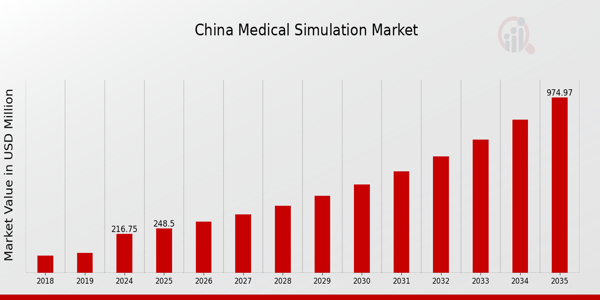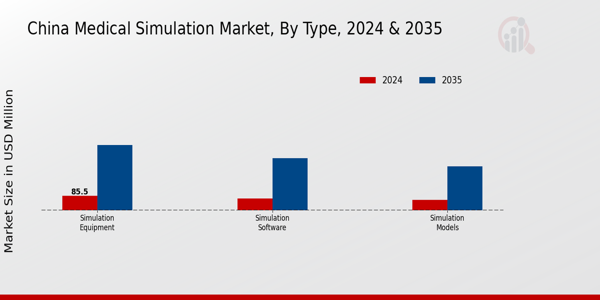China Medical Simulation Market Overview
As per MRFR analysis, the China Medical Simulation Market Size was estimated at 201 (USD Million) in 2023. The China Medical Simulation Market Industry is expected to grow from 216.75(USD Million) in 2024 to 975 (USD Million) by 2035. The China Medical Simulation Market CAGR (growth rate) is expected to be around 14.648% during the forecast period (2025 - 2035)
Key China Medical Simulation Market Trends Highlighted
The China Medical Simulation Market is experiencing significant growth driven by several key factors. The increasing demand for high-quality medical education has prompted healthcare institutions to integrate advanced simulation technologies into their training programs. This shift is largely fueled by the need to enhance the quality of healthcare services and patient safety in China, as the government emphasizes improving medical training standards.
Furthermore, the rise in complex medical procedures necessitates a focus on hands-on practice and skill development, which broadens the appeal of simulation methodologies among medical professionals.There are also possibilities for businesses in the region to create cost-effective training programs specifically designed for China’s healthcare system. These programs could greatly benefit the healthcare system and could be developed through the partnership of educators, healthcare providers, and technology businesses.
The increased investment in healthcare infrastructure from the Chinese government broadens the development prospects for technological medical simulation systems, improving accessibility and adoption throughout many areas. Recently, there has been a significant increase in the use of virtual reality (VR) and augmented reality (AR) technologies for medical training, which has made learning more interactive and engaging.
This trend aligns with the broader technological advancements seen in China and addresses the increasing expectations of a tech-savvy generation of medical professionals. Simulation-based training tools are being recognized as essential for effective learning, resulting in a growing acceptance and incorporation of these solutions in medical schools and hospitals across the country. Overall, the landscape of the China Medical Simulation Market is evolving rapidly, offering promising avenues for innovation and development.

Source: Primary Research, Secondary Research, Market Research Future Database, and Analyst Review
China Medical Simulation Market Drivers
Rising Demand for Advanced Healthcare Training
The increasing complexity of medical procedures and the need for skilled healthcare professionals are driving the demand for advanced healthcare training in the China Medical Simulation Market Industry. With significant investments in healthcare infrastructure, the Chinese government aims to enhance the quality of medical education. According to the Ministry of Education of the People's Republic of China, there has been a 25% increase in medical school enrollments from 2017 to 2021, indicating a growing demand for innovative training methodologies.
Organizations like the China Medical Board are actively promoting medical simulation education, facilitating partnerships between educational institutions and healthcare organizations, which underscores the necessity of integrating simulation-based learning in medical curricula. This trend is expected to propel growth in the China Medical Simulation Market, as more institutions adopt simulation technologies to ensure comprehensive training for medical professionals.
Government Support and Funding Initiatives
The Chinese government has initiated various funding programs to support medical education and technological advancements in the healthcare sector. The recent Five-Year Plan for Nursing Development, which allocates substantial funds for healthcare training facilities, helps encourage the adoption of sophisticated medical simulation technologies.
The National Health Commission has reported a 15% increase in funding for healthcare training programs from 2020 to 2022, emphasizing the importance of simulations for hands-on experience.Such government initiatives not only increase the adoption of simulation in medical training but also enhance the overall quality of healthcare services in China, making it a significant driver for the China Medical Simulation Market Industry.
Technological Advancements in Medical Simulation
The rapid technological advancements in virtual and augmented reality are transforming the landscape of medical simulation in China. Companies such as ViVitro Labs and Sinomed have reported substantial developments in their simulation technologies, leading to enhanced realism and engaging training experiences for medical professionals. A report by the China Association for Medical Devices Industry stated that investments in high-fidelity simulation technologies have surged by 40% over the past three years.
As these technologies become more prevalent, institutions are likely to expand their simulation-based training programs to improve the preparedness of healthcare providers, thereby driving growth in the China Medical Simulation Market Industry.
China Medical Simulation Market Segment Insights
Medical Simulation Market Type Insights
The China Medical Simulation Market is experiencing substantial growth, driven by the increasing demand for advanced medical training solutions and educational improvements across healthcare sectors. In this landscape, the Type segment encompasses a vital classification that includes Simulation Software, Simulation Equipment, and Simulation Models. Each of these components plays a crucial role in the effectiveness and efficiency of medical training programs. Simulation Software serves as an essential tool for medical professionals, offering a wide array of virtual scenarios that mimic real-life situations, enabling practitioners to develop their skills in a risk-free environment.
This tool is particularly pertinent in China, where healthcare professionals are increasingly seeking to enhance their competencies through digital platforms. Furthermore, Simulation Software often integrates with advanced technologies such as artificial intelligence, significantly improving training realism and user experience.Simulation Equipment is another cornerstone in the Type segmentation. This includes mannequins, virtual reality headsets, and other interactive devices that facilitate hands-on training. The significance of Simulation Equipment in the Chinese market cannot be overstated, as it provides tangible options for learners to practice clinical skills.
The equipment allows for immediate feedback, enhancing learning outcomes, which is particularly beneficial in a rapidly modernizing healthcare system in China that seeks to keep pace with global standards.Simulation Models, encompassing various anatomical and clinical scenario representations, remain a critical aspect of medical education and are widely utilized in China. These models aid in visualizing complex procedures, thereby improving understanding and retention of knowledge among medical trainees.
Their role is especially prominent in surgical training, where the precision of techniques can significantly influence patient outcomes. The growth drivers for this segment are supported by increasing investments in medical training facilities, government initiatives to enhance healthcare education, and the rising demand for qualified healthcare professionals in Chinese markets. Challenges such as high initial costs of advanced simulation systems and the need for continual updates to software and equipment to keep pace with evolving medical practices are present.
However, the opportunities are expansive as more educational institutions and hospitals recognize the necessity of simulation in effective training protocols. Overall, the Type segment of the China Medical Simulation Market reflects a dynamic environment fueled by innovation, technology adoption, and a commitment to improving healthcare training standards in the region.

Source: Primary Research, Secondary Research, Market Research Future Database, and Analyst Review
Medical Simulation Market Application Insights
The China Medical Simulation Market exhibits a dynamic landscape within the Application segment, primarily composed of Surgical Simulation, Patient Simulation, Procedural Simulation, and Virtual Reality Simulation. With a growing emphasis on practical training and skill enhancement, Surgical Simulation has emerged as a pivotal aspect, enabling healthcare professionals to practice intricate procedures in a risk-free environment. Patient Simulation plays a vital role in mimicking real-life clinical scenarios, enhancing the training experience for medical practitioners.The Procedural Simulation segment stands out significant as it offers detailed scenarios to prepare users for a variety of medical procedures, thereby increasing operational confidence.
Virtual Reality Simulation is rapidly gaining traction, providing immersive experiences that enhance learning and retention rates among trainees. Collectively, these applications are becoming integral to educational programs within China, driven by the increasing demand for efficient training methodologies in the rapidly evolving healthcare sector. Additionally, technological advancements and government initiatives towards enhancing medical education are bolstering the growth of these applications, solidifying the importance of the China Medical Simulation Market in fostering skilled healthcare professionals.
Medical Simulation Market End Use Insights
The China Medical Simulation Market, with a robust growth trajectory, exhibits a diverse range of applications across various End Use segments, including Hospitals, Academic Institutions, Military Organizations, and Healthcare Providers. Hospitals play a critical role in the adoption of medical simulation technology, utilizing it to enhance surgical training and improve patient outcomes. Academic Institutions have incorporated simulation into their curricula to prepare healthcare professionals with hands-on skills, ensuring they meet the high standards of the industry.Military
Organizations leverage medical simulation for training purposes, focusing on trauma care and emergency response, which ultimately leads to better preparedness in real-world scenarios. Healthcare Providers utilize these simulations to continuously enhance their staff's competencies and adapt to evolving healthcare practices. The increasing emphasis on training quality and patient safety drives significant investment in simulation technologies within these segments, making them instrumental to the advancement of medical education and practice efficiency in China.As a result, the China Medical Simulation Market segmentation reflects a strategic response to the growing need for practical training solutions amid evolving healthcare challenges.
Medical Simulation Market Technology Insights
The Technology segment of the China Medical Simulation Market is crucial for enhancing medical education and training through advanced methodologies. High-Fidelity Simulation, which employs high-quality manikins and sophisticated scenarios, is significant for providing healthcare professionals with realistic clinical experiences, thus improving their performance in real-life situations. Low-Fidelity Simulation focuses on basic skills and simulation techniques using simpler models, and it is important for foundational training in medical education.Virtual Simulation has emerged as a transformative approach, utilizing computer-based technologies to create immersive learning environments that allow practitioners to rehearse clinical procedures.
This segment is supported by growing government initiatives in China to modernize healthcare training and improve patient safety outcomes. The rising demand for skilled healthcare professionals drives the need for innovative technology solutions, making this segment a focal point in the broader medical simulation industry. Overall, the China Medical Simulation Market segmentation in Technology not only reflects advancements in medical training but also emphasizes the importance of adapting educational practices to meet evolving healthcare challenges.
China Medical Simulation Market Key Players and Competitive Insights
The competitive landscape of the China Medical Simulation Market is rapidly evolving as the need for advanced healthcare education and training continues to grow. Driven by technological advancements and a greater emphasis on practical medical training, this market is witnessing significant investment from various stakeholders, including educational institutions, healthcare providers, and technology companies. The competitive insights reveal a landscape where companies are increasingly focused on innovation, tailored solutions, and strategic partnerships to enhance their offerings.
The market is characterized by a diverse array of players, each striving for a competitive edge through specialized services, cutting-edge technologies, and localized approaches that cater to the specific needs of China's healthcare sector.Siemens Healthineers has established a robust presence in the China Medical Simulation Market, leveraging its global reputation and innovative technologies to deliver high-quality simulation solutions. The company is recognized for its comprehensive portfolio that integrates clinical competence with advanced simulation capabilities, enabling healthcare professionals to benefit from realistic training scenarios.
Siemens Healthineers stands out due to its strong emphasis on research and development, which allows it to continuously improve its product offerings. Moreover, its extensive partnerships with medical institutions and universities across China enhance its market penetration and foster collaboration, ensuring that the training solutions meet the local healthcare demands while maintaining high educational standards.Shanghai United Imaging Healthcare is another key player in the China Medical Simulation Market, which has carved a niche by focusing on technological innovation and integrated healthcare solutions.
The company provides a range of key products and services that cater to the simulation needs of medical professionals, including high-fidelity simulators and virtual reality training tools. Its market presence is further bolstered by unique strengths in software development, advanced imaging systems, and a commitment to enhancing patient care through simulation-based education. Shanghai United Imaging Healthcare has pursued strategic mergers and acquisitions to enhance its technological capabilities and market reach within China, enabling it to respond effectively to the growing demand for medical simulation.
By combining its strengths in imaging technology with simulation solutions, the company is well-positioned to contribute significantly to the evolving landscape of medical training in the region.
Key Companies in the China Medical Simulation Market Include
- Shanghai United Imaging Healthcare
- BenGurion University of the Negev
- Shenzhen Mindray BioMedical Electronics
- China National Pharmaceutical Group
- Medical Simulation Corporation
China Medical Simulation Market Industry Developments
The China Medical Simulation Market has seen notable developments recently, particularly with Siemens Healthineers enhancing its product offerings and investing in local partnerships to strengthen its presence. Shanghai United Imaging Healthcare continues to expand its simulation technologies, aiming to improve medical training efficacy. 3D Systems has also been active, focusing on advancements in 3D printing to support customized medical simulations.
In light of recent activities, there has been a surge in investments in simulation technologies, driven by growing healthcare demands in China, with the market expected to see robust growth due to a rising emphasis on healthcare quality and workforce readiness.
In terms of mergers and acquisitions, significant activity includes CAE Healthcare's acquisition of a local simulation firm aimed at expanding its footprint in China, reported in August 2023. Additionally, GE Healthcare has been pursuing collaborations with Chinese universities to enhance medical training capabilities through simulation. The last two to three years have seen the market's growth potential highlighted by increased funding incentives from the Chinese government towards medical education, marking a pivotal shift in the industry landscape. Major companies like Fujifilm Holdings and Philips Healthcare are also making strides in integrating advanced simulation tools within Chinese healthcare institutions.
China Medical Simulation Market Segmentation Insights
Medical Simulation Market Type Outlook
Medical Simulation Market Application Outlook
- Virtual Reality Simulation
Medical Simulation Market End Use Outlook
Medical Simulation Market Technology Outlook
| Report Attribute/Metric Source: |
Details |
| MARKET SIZE 2023 |
201.0(USD Million) |
| MARKET SIZE 2024 |
216.75(USD Million) |
| MARKET SIZE 2035 |
975.0(USD Million) |
| COMPOUND ANNUAL GROWTH RATE (CAGR) |
14.648% (2025 - 2035) |
| REPORT COVERAGE |
Revenue Forecast, Competitive Landscape, Growth Factors, and Trends |
| BASE YEAR |
2024 |
| MARKET FORECAST PERIOD |
2025 - 2035 |
| HISTORICAL DATA |
2019 - 2024 |
| MARKET FORECAST UNITS |
USD Million |
| KEY COMPANIES PROFILED |
Siemens Healthineers, Shanghai United Imaging Healthcare, 3D Systems, Laerdal Medical, BenGurion University of the Negev, Shenzhen Mindray BioMedical Electronics, China National Pharmaceutical Group, Informa Markets, Philips Healthcare, Fujifilm Holdings, CAE Healthcare, Animatronics, Medical Simulation Corporation, GE Healthcare, Surgical Science |
| SEGMENTS COVERED |
Type, Application, End Use, Technology |
| KEY MARKET OPPORTUNITIES |
Increasing demand for healthcare training, Government initiatives for medical education, Technological advancements in simulation, Growing awareness of patient safety, Expansion of telehealth and virtual training |
| KEY MARKET DYNAMICS |
growing healthcare investments, increasing adoption of technology, rising demand for trained professionals, government regulations and standards, emphasis on patient safety |
| COUNTRIES COVERED |
China |
Frequently Asked Questions (FAQ):
The China Medical Simulation Market is expected to be valued at 216.75 million USD in 2024.
By 2035, the China Medical Simulation Market is projected to reach a value of 975.0 million USD.
The expected CAGR for the China Medical Simulation Market from 2025 to 2035 is 14.648%.
The China Medical Simulation Market is segmented into Simulation Software, Simulation Equipment, and Simulation Models.
Simulation Software is valued at 70.25 million USD in the China Medical Simulation Market for the year 2024.
The Simulation Equipment segment is expected to reach 395.0 million USD in the year 2035.
Key players in the China Medical Simulation Market include Siemens Healthineers, Laerdal Medical, and GE Healthcare among others.
The Simulation Models segment is projected to be valued at 265.0 million USD by the year 2035.
The growth of the China Medical Simulation Market is driven by the increasing demand for advanced medical training technologies.
Global economic factors can impact the investment flow and technology adoption in the China Medical Simulation Market.
















